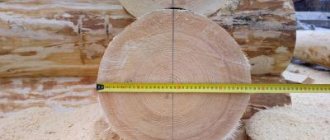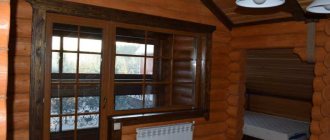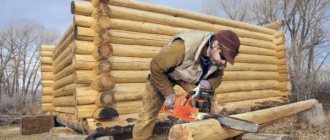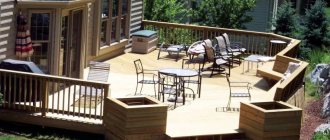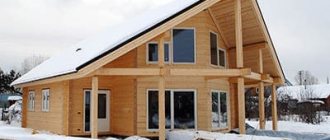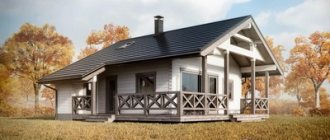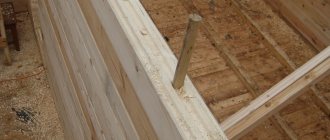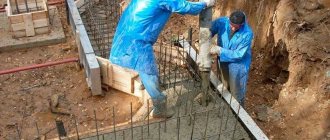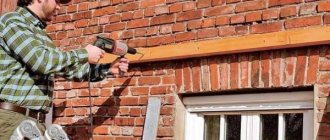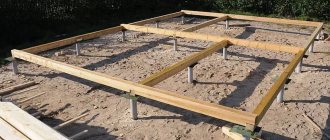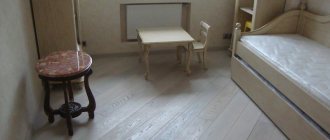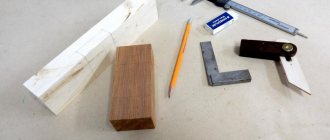When choosing a reliable material for fencing, wood is by no means the last place. The environmental friendliness and availability of this raw material make it popular among owners of suburban areas.
The most durable fence is considered to be made of logs, the service life of which can reach 100 years. To do this, it is important to choose good raw materials and strictly follow all stages of the construction process.
Advantages and disadvantages of use
The obvious advantages of this design are as follows:
- High level of strength. The fence perfectly protects the site from strong gusts of wind and precipitation, and can withstand heavy loads.
- Shelter from prying eyes. Dense laying of logs ensures the integrity of the fence, so that the area is not visible from the street.
- Long service life. Provided high-quality protection from moisture and insects.
- Distinctive appearance. Goes well with various design solutions.
- Inaccessibility. A log fence is a reliable defense against intruders, since it is difficult to climb over a thick wall.
- Installation speed. Installing a wooden fence is much faster than pouring concrete or laying brick or stone.
A massive log structure will have a lot of weight, which will entail the construction of a reliable foundation. And you won’t be able to handle the installation of logs alone, so you’ll have to hire help.
In addition, the price of raw materials is quite high, and wood is a flammable material.
A modern alternative is siding, which perfectly imitates a log structure. It is made of metal and the same wood, which weighs less.
Finishing
Of course, no one will use pigment paints: it is important to preserve the color. For this purpose, all kinds of varnishes, impregnations, and stains are used. The result of firing is interesting, when they carefully use a blowtorch, creating a deliberate antiquity.
It must be remembered that before painting, the logs should be protected again by subjecting them to chemical treatment. You can use effective heavy chemicals, remembering to protect yourself with respirators and protective clothing. Within a week, the harmful components will disappear, and the log fence will no longer be threatened.
It is not recommended to varnish, burn or coat a finished fence with any composition in hot weather. It is ideal to choose early autumn for this work with air temperatures from +5⁰ to 10⁰. No rain is expected, otherwise the protective compounds will simply be washed away. Palisade fencing requires regular prevention of cracking and biological damage at least once every 3 years.
Actually, the fence is ready. All that remains is to hang the doors, make a forged lock with hinges, and the fortress in the spirit of the Russian principality will be used in modern times.
Andrey Levchenko
Author of publications on 1Drevo.ru with the topics: Windows for the attic | Rounded fence | Five-wall log house | Repair of a cylinder house | Production of cylinders | House layout | Rounded dacha | Induction electric boiler | Solar panels | Canadian log house | Log bathhouse | Wall insulation | Cottage - laminated timber, etc.
Was this publication useful to you?
Bookmark it on social networks!
Total score: 6Votes: 12
Sealant for sealing joints in a house made of rounded logs
Mansard roof on a house made of calibrated logs - progress of work
We recommend! — Encyclopedia Wooden Houses — NEW
You can find out detailed and expanded information on the topic of the article from the book “Wooden Houses,” which reflects all stages of building a house, from laying the foundation to installing the roof. Book price = 77 rubles.
You may also be interested in other BOOKS on building houses from wood with your own hands.
We recommend other posts on this topic:
Carrying out work on constructing a log house from floor to roof
How to make an extension to a log house with your own hands
Children's town made of rounded logs
How to make a canopy over a porch with your own hands
DIY arched canopy - choice of material
Townhouse for two families - features of the construction of a duplex from cylinders
We choose quality material
It is better to take coniferous species (pine, spruce, larch). It is believed that their resin is an excellent preservative that provides resistance to environmental influences and a long service life.
The optimal type of raw material is wood, which does not need to be pre-rounded. The sharpening angle is 45 degrees. The surface is cleared of bark.
It is advisable to take logs of the same diameter, from 100 to 150 mm. There are fences with a larger diameter, but this increases the thickness of the structure, which means the load on the foundation increases.
For fences where the main load falls on the cross beams, it is recommended to use 100 mm round timber or half timber.
It is also important to remember that the purchased material is dry. Wet round timber taken for the construction of a fence begins to crack over time and cracks form, which is especially noticeable in the areas of the log house. The consequences are deformation of the entire structure, loss of appearance.
Users often search for:
- Wooden fence in checkerboard pattern
- Timber fence
Wicker picket fence
Solid logs are not required to construct a building envelope of this type. Yes, and a wicker fence can be called a palisade in the usual sense of the word with great difficulty. A fence stake can be made from any pole. As a rule, medium-sized tree branches are used for this, preferably from hardwood. For many regions of our country, blanks made from birch or pine are relevant.
The number of frame stakes can be calculated very easily. You just need to measure the length of the perimeter of the future fence in meters, multiply the result by two and add a few units for compacting the ligaments of corner turns or culling.
The material for knitting the wattle fence can also be prepared yourself in any possible places. As a rule, in the floodplains of rivers there are many trees of the willow family and thickets of bushes. Flexible and thin willow branches are an excellent material for wicker fencing. In the forest you can find thickets of hazel or willow. The most important condition is that the branches are filled with juice, “alive”. This will prevent creases during working bending of the vine.
Suitable types and sizes of fence logs
You can build the following structures yourself:
- Palisade The logs are placed in a vertical position close to each other in the ground. The lower part must be waterproofed. The top is symmetrically trimmed with an ax on both sides at an angle of 30-45 degrees to form a stake. The optimal diameter is 100-150 mm.
- In the second option, massive supports are mounted along the edges of the fence, followed by smaller supports. They are mounted on transverse slats and do not come into contact with the soil.
- A fence is formed from horizontally located logs. They can be fixed close to each other or leave a small gap.
- Imitation of a log structure in the form of siding. Light in weight. Does not require pouring a massive foundation.
The length of the wood is chosen based on the height of the future fence. The average size is from 170 to 200 cm, but experts recommend taking with a margin of up to 40 cm. If necessary, it is better to cut off the excess.
When calculating the amount of material, it is also worth taking a couple more logs. To obtain an accurate result, the length of the fence is divided by the diameter of one unit of raw material.
Non-standard methods of fastening boards
Does simple vertical fastening of boards seem too primitive and boring to you? No problem, there are many more interesting solutions!
For example, you can assemble a fence using the wattle fence principle. The boards are attached in a curved state. Trying to straighten out, they will fit quite tightly to the support pillars.
Another great option is to fill the space between the supports with wood siding. We fasten the sheathing boards starting from the bottom, maintaining a 25 mm overlap.
Fences made in the form of blinds look no less original. By laying the boards with a downward slope towards the street, you will create an invisible fence that is resistant to wind loads.
Fence-blinds
Fence-blinds
The boards can also be nailed at the ends. To perform the highest quality cladding, we first make markings on each rack.
If metal posts are installed, they can be hidden by sheathing the posts on both sides. We close the metal supports on top with wooden plugs.
If desired, you can make the fence more original using wooden support posts. We make inclined cuts-grooves in the supports, and then insert the ends of the lamellas into them. Additionally, we fasten each strip with self-tapping screws. To hide the fastening points, we cover the screws with wooden covers. We crown the upper part of the supports with plugs.
To make the fence look more original and modern, we can fill the boards with a small gap (up to 15 mm). At the same time, the narrower the boards are (of course, within reasonable limits), the more interesting the fence design will be.
You can also use boards of different widths. When choosing this cladding method, be sure to ensure that the pattern on adjacent sections matches.
There are a lot of options for designing a wooden fence. Choose the one you like and start building the fence. You already have all the knowledge necessary for this.
Prices for various types of construction boards
Construction boards
Good luck!
Video – DIY wooden fence
We protect raw materials from moisture
To prevent the process of rotting and deterioration of wood, it can be pre-treated. An economical solution is to coat or immerse the lower part (the first 60 cm) in hot bitumen or creosote. An alternative is to char the surface with fire or a gas burner.
To protect the upper part from moisture, visors made of metal, stone, and plastic are installed. But it is much safer to treat the raw materials with protective solutions and impregnations along the entire length. You will find a list of recommended products and application instructions here: “How to paint a wooden fence.”
DIY options for laying a log fence
Only two are considered generally accepted. We will analyze the installation technology of each of them in more detail.
Horizontally
This structure of the structure goes well with buildings assembled from timber or the same log.
An important advantage is the low consumption of sectional material, but for the construction of supports and foundations you will have to purchase concrete and brick.
Work order:
- We carry out the markings. We dig a trench up to 60 cm wide along the perimeter.
- We compact the bottom. We fill in a cushion of crushed stone and sand. Let's tamp again.
- We carry out reinforcement. We install a frame made of steel wire. We install it in a trench.
- Concreting to ground level. Hardening time - up to 2 weeks.
- On top of the finished foundation we form a strip of stone or brick with cement mortar. The height of the masonry can reach 80 cm.
- We form supports. The material for them is similar to tape. We install them at a distance of 4 to 6 m from each other.
- After the pillars have completely hardened, we begin laying the sectional material. It is recommended to treat the ends of the logs with an antiseptic. The gaps between elements are kept to a minimum.
As a decoration, you can make skates from unedged boards or slabs and install them at an angle of 90 degrees.
Vertical
The popular name for such a fence is a palisade.
Installing logs this way has several options:
- driving sharp stakes into the ground;
- digging elements into a dug trench;
- installation on top of a reinforced concrete strip (as with horizontal laying).
Regardless of your choice, you need to mark by stretching a rope or cord around the perimeter of the future fence. For the latter options, you need to prepare a trench up to 0.8 m deep, with a width equal to the bayonet of a shovel. All wooden elements are treated with protective agents using a spray gun or sprayer.
To strengthen the structure, it is recommended to nail a horizontal strip or beam to the cylinders.
It is better to make a wicket or gate from the same material. If you want to make the installation process easier, you can use logs sawn lengthwise.
A good solution is to use scraps of asbestos-cement pipes as clamps for log supports. The diameter of the pipes must correspond to the diameter of the raw material. They are installed in the trench every 2 m. After the concrete strip is poured and hardened, logs are inserted into the sections.
Photo gallery of finished fencing
The photo shows different methods of laying cylinders, examples of combined log fences.
For owners of suburban areas who want a fence made of natural material, wooden logs will be an excellent solution. In addition, in terms of strength and aesthetics, they are not inferior to concrete, brick or stone.
